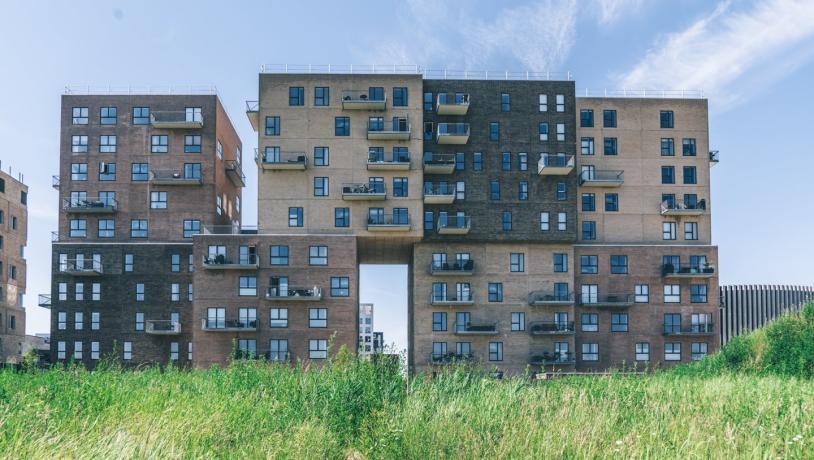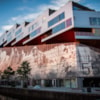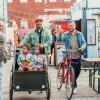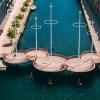Where Copenhagen’s Urban Jungle Meets its Savannah
By James Clasper
Picture the Danish capital and what typically comes to mind are its colourful medieval streets, its picture-perfect harbour, and its trendsetting neighbourhoods such as Vesterbro and Nørrebro. But don’t forget Ørestad. Blessed with world-class architecture, stunning nature, cutting-edge examples of sustainable living, and an increasingly exciting food scene, Copenhagen’s city-within-the-city may be its best-kept secret.
“I feel like I’m in an experiment.”
The woman who told me this was sitting outside a café in the southern Copenhagen neighbourhood of Ørestad, enjoying a glass of wine, the autumn sunshine and a front-row view of a brand-new building.
“Every time I come back from vacation,” the woman chirped, “it’s a new neighbourhood.” As I soon discovered, her excitement is entirely jus-tified. Because nowhere in the Danish capital feels as ripe with potential as Ørestad.
A quick history lesson: twenty years ago, Ørestad didn’t even exist—at least not as a metropolitan area. One of Copenhagen’s most ambitious urban-development projects, it’s a city within the city, built alongside a nature reserve on the island of Amager, south of Copenhagen's medieval centre. Less than five kilometres long and barely half a kilometre wide, Ørestad looks like a crooked finger when marked on a map.

Photo:Simon Bang
Today, Ørestad is one of the most up-and-coming neighbourhoods in the Danish capital. One reason, as the woman outside the café pointed out, is that new buildings are going up all the time, in turn attracting new residents and businesses. Increasingly, too, Ørestad is a neighbourhood with growing appeal for locals and visitors alike, whether they’re from Copenhagen or beyond.
And that's partly what makes Ørestad especially exciting right now. Because it’s fair to say that, at first, with its breakneck pace of construction, sharp lines, and large-scale modern architecture, Ørestad didn’t please everyone. Critics dubbed it Copenhagen’s Dubai—and it wasn’t meant as a compliment. Others griped about its windswept streets. And despite a slew of striking new features—including one of the world’s greenest hotels and Scandinavia’s largest conference centre—Ørestad’s biggest attraction was for years a shopping mall. Not any more, though. First, there’s its skyline.
Ørestad boasts some of the Danish capital’s most photogenic buildings—so bring a charger. The first time I visited the neighbourhood, I tried to capture them all on camera, and my phone ran out of juice.
Another tip: ask Ørestad resident Mira M. Cordsen to show you around. Through Experience Ørestad, she leads tours of the neighbourhood, showcasing architectural masterpieces that exemplify the cutting-edge design that Denmark is well known for today.
In Ørestad, Cordsen explains, you can “enjoy architecture that’s there to be experienced because of its form not its function”. She starts our tour in Ørestad City. The commercial hub is home to two iconic buildings designed by BIG, Danish star architect Bjarke Ingels’s firm.
Mountain Dwellings is an 11-storey apartment block that resembles an Alpine hillside, while the apartments of VM Houses have triangular glass balconies that jut outward like shards of ice. I can’t decide which is the more Instagram-friendly building, but it turns out the correct answer is neither: it’s the award-winning 8 House, in Ørestad South.
Shaped like a figure of eight—and also designed by BIG—the 8 House is a 10-storey building comprising more than 400 apartments and commercial units. They’re connected via a kilometre-long path that loops like a bowtie and leads all the way to the top. Which is where you can fully grasp Ørestad’s other big selling point: its proximity to nature.
Photo:Martin Heiberg
You see, the top of the 8 House affords views across Amager Nature Park—some 3,500 hectares of fields, forests, marshes and wetlands, which are home to hundreds of bird and plant species. Look closely, too, and you’ll spot sheep and cows grazing in the pastures of Kalvebod Fælled (though if that notorious wind is blowing in the right direction, you’ll probably smell them first).
“The first time I came out here, I was like, ‘Wow, can you really live so close to nature and have a metro station?”
says Cordsen, who moved to Ørestad from northern Copenhagen almost a decade ago. “What makes it special is the feeling you get of nature and architecture saying to one another, ‘It’s you and me together’. It feels like a new way of living out here because you can go straight from the savannah to the metropolis.
“Nature is our biggest draw,” agrees Stig Thorsteinsson, who opened his eponymous wine bar a stone’s throw from Kalvebod Fælled in 2019. “Nature is right outside your door here. Almost every apartment has a view of the sunset and nature from their window.”
In Ørestad, however, it isn’t just about enjoying the view. It’s about venturing into the park to experience nature “red in tooth and claw”. One morning I cycled along a stretch of the park’s 25-kilometre-long coastline, stopped at an observation tower and tried to identify wildlife in the bird sanctuary. (No such joy. Another top tip? Stop by the Naturcenter Amager first and pick up a guide to the sanctuary’s 300-plus species of migrating and breeding bird.)
Photo: Peter Holliday
However, cycling back to Ørestad through Pinseskoven, a pretty birch forest on the southeastern corner of Kalvebod Fælled, I did spot what must be Copenhagen’s most memorable—if primitive—accommodation: Six campsites, where visitors can pitch a tent for the night, as well as two wooden shelters where one can simply roll out a sleeping bag.
As tempting as a night under the stars seemed, an autumnal chill was in the air, so I retreated to the urban jungle—and creature comforts—of Ørestad South. But not before stopping at Traktørstedet. Located next to the Naturcenter Amager—where visitors can rent bicycles, pick up guides and buy firewood—it’s a cozy daytime café with spectacular views of Kalvebod Fælled, making it the perfect pitstop for the famished and the footsore.
Owner Hanne Barild has lived in the area for almost 30 years and opened Traktørstedet in 2016, sprucing up an old restaurant to serve delicious “homemade” food—including a burger made with beef from the Galloway cattle grazing metres away. Many Copenhagen restaurants claim to be “farm-to-table”. Traktørstedet is the real deal. It’s also one of several bars, cafés and restaurants springing up in what was once deemed a culinary desert.
Photo:Mellanie Gandø
Take COBRAcph, an “urban farmshop and events café”, whose enthusiastic owner Mette Bugge wants to “connect the countryside with the city and create a sense of community” in Ørestad South. As well as offering fresh bread and pastries, she sources organic eggs and vegetables from nearby farms, showcases local artists, and has a jam-packed events calendar, including wine tasting, communal dining and live music.
Other notable new arrivals on Ørestad’s culinary scene include Thorsteinsson’s trendy wine bar and bottle shop, which specialises in “natural, organic and biodynamic” wine from Italy and Slovenia; Moo Moo Is Bar, which makes outstanding vegan gelato; and the Orango café, which works with organisations in Indonesia to support sustainable coffee cultivation and the conservation of endangered rainforest species.
The fact that places such as this—bars, restaurants and shops striving to sell sustainable products, minimise their carbon footprint and put the planet first—exist in Ørestad today is entirely unsurprising. Because, as Cordsen explains, sustainability is very much the watchword in the neighbourhood now. And the hottest trend of all is “upcycling”.
To illustrate what she means, Cordsen takes me to Copenhagen Towers, a 22-storey office block designed by Foster + Partners. Its glass-roofed atrium may be filled with 60 olive trees and gorgeous wooden benches, but even more interesting are the recycled and upcycled materials used in its construction: reused timber wall cladding, concrete flooring sourced from building debris, and sound-dampening PET plastic felt ceiling panels.
Photo:PR
There’s a similar philosophy at the nearby Resource Rows—a modern apartment block built using recycled bricks from the Carlsberg brewery. Yet the undisputed champion of sustainable architecture is Upcycle Studios—a row of 20 townhouses built using Danish waste materials that were otherwise destined for landfill or the incinerator. For instance, the shell of the building was made using leftover concrete from the construction of the Copenhagen metro, while the windows were sourced from abandoned buildings in Jutland.
Moreover, in a nod to the growth of the sharing economy and the popularity of working from home, each townhouse at Upcycle Studios is a flexible space that can be used as both a home and an office, workshop or retail space. Given the origin of the materials used, you might think the buildings would be unsightly. Far from it. Upcycle Studios are a stylish example of modern living—and a glimpse of how we might increasingly design buildings.
If Upcycle Studios shows how waste materials can be sustainably reused, then Simian demonstrates how space itself might be reimagined. That’s because it’s an exhibition space for experimental contemporary art—located underground, in a disused cycling garage.
Photo:GRAYSC
With its whitewashed walls, skylights and loud echo, the 1,300-square-metre space seems tailor-made for showing large-scale works, such as video projections and sculptures. One of the artists behind Simian, Markus von Platen, says the space is “quite different”, and gives them an opportunity to exhibit large-scale art that is “super relevant and has a unique story”.
Which, in a way, makes it just like Ørestad itself. Cordsen’s tour over, I jump back on the metro—a futuristic monorail in Ørestad—and reflect on what I’ve seen. Ørestad may not have the higgledy-piggledy marvels of Copenhagen’s medieval centre nor the hip allure of the city’s trendier neighbourhoods. But in its world-class architecture, abundance of nature and pioneer-spirit pursuit of sustainable living, it has a vibe that you rarely sense in the fairytale-pretty parts of the Danish capital.
Ørestad was for years of interest only really to students of urban planning. They will continue to pound its pavements in search of its best-known buildings—and rightly so. But even if you can’t tell a balcony from a balustrade, Ørestad should be on your bucket list. It’s home to Copenhagen’s most glorious green space, it offers a glimpse of the future, and those buildings really are spectacular. Just remember to bring your phone charger.














